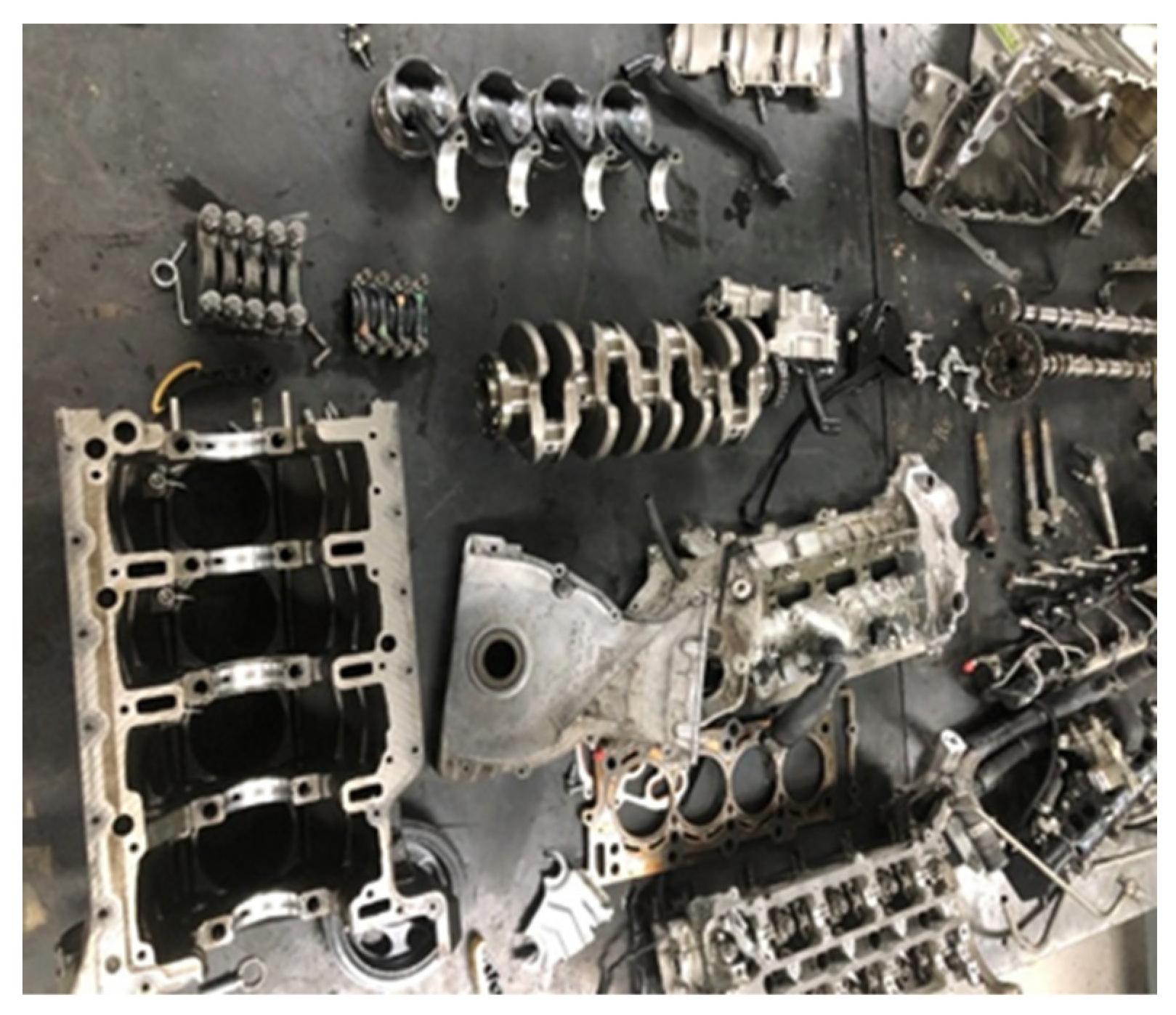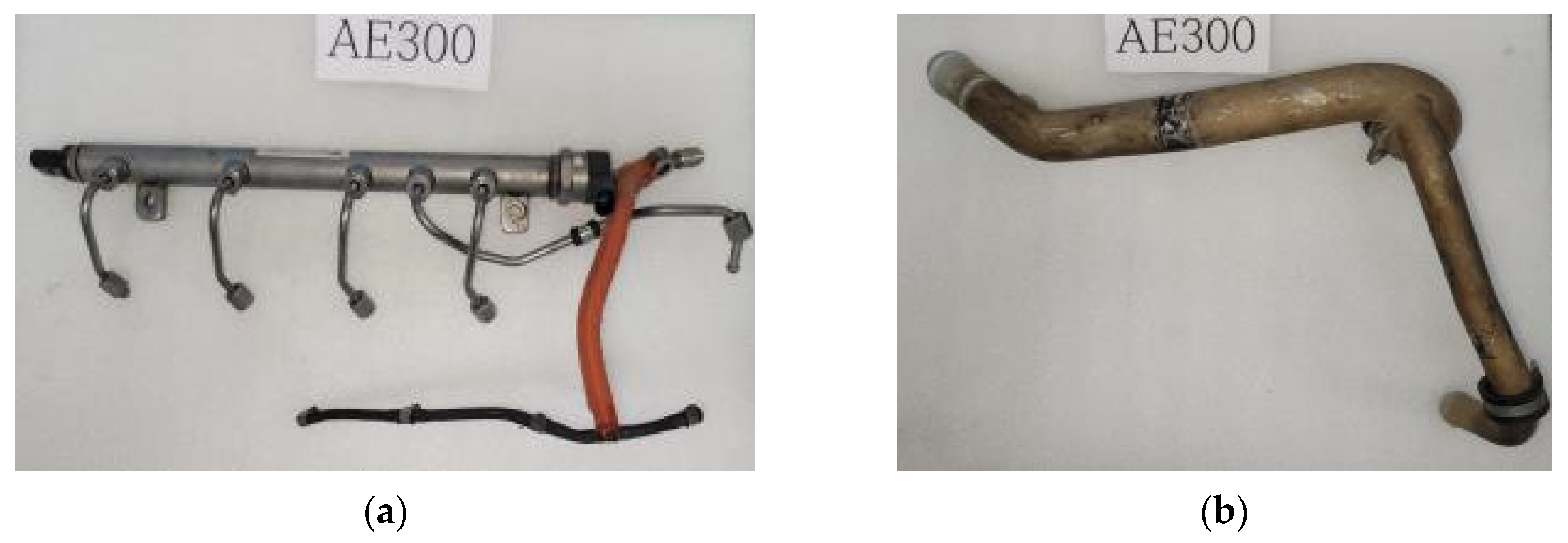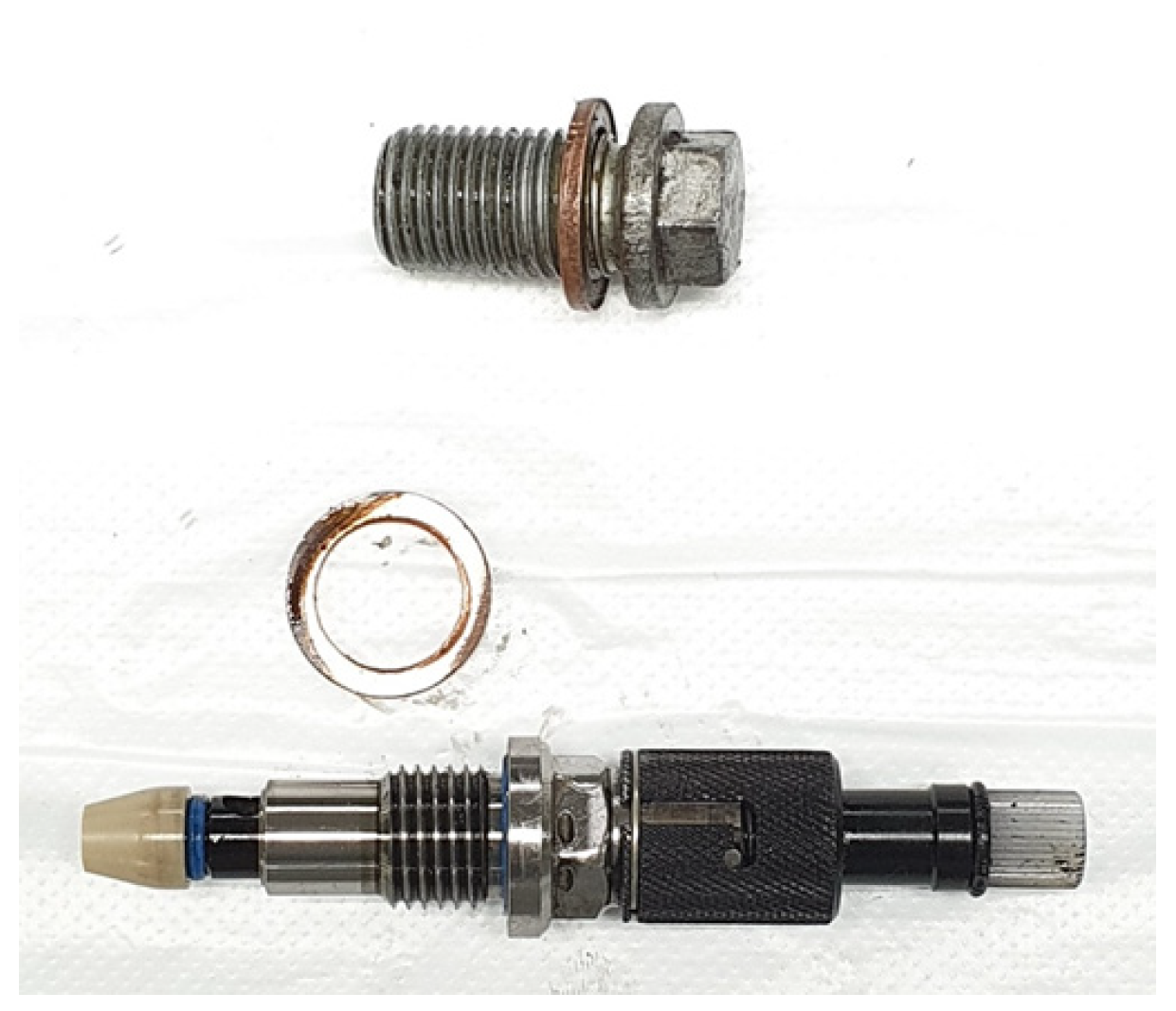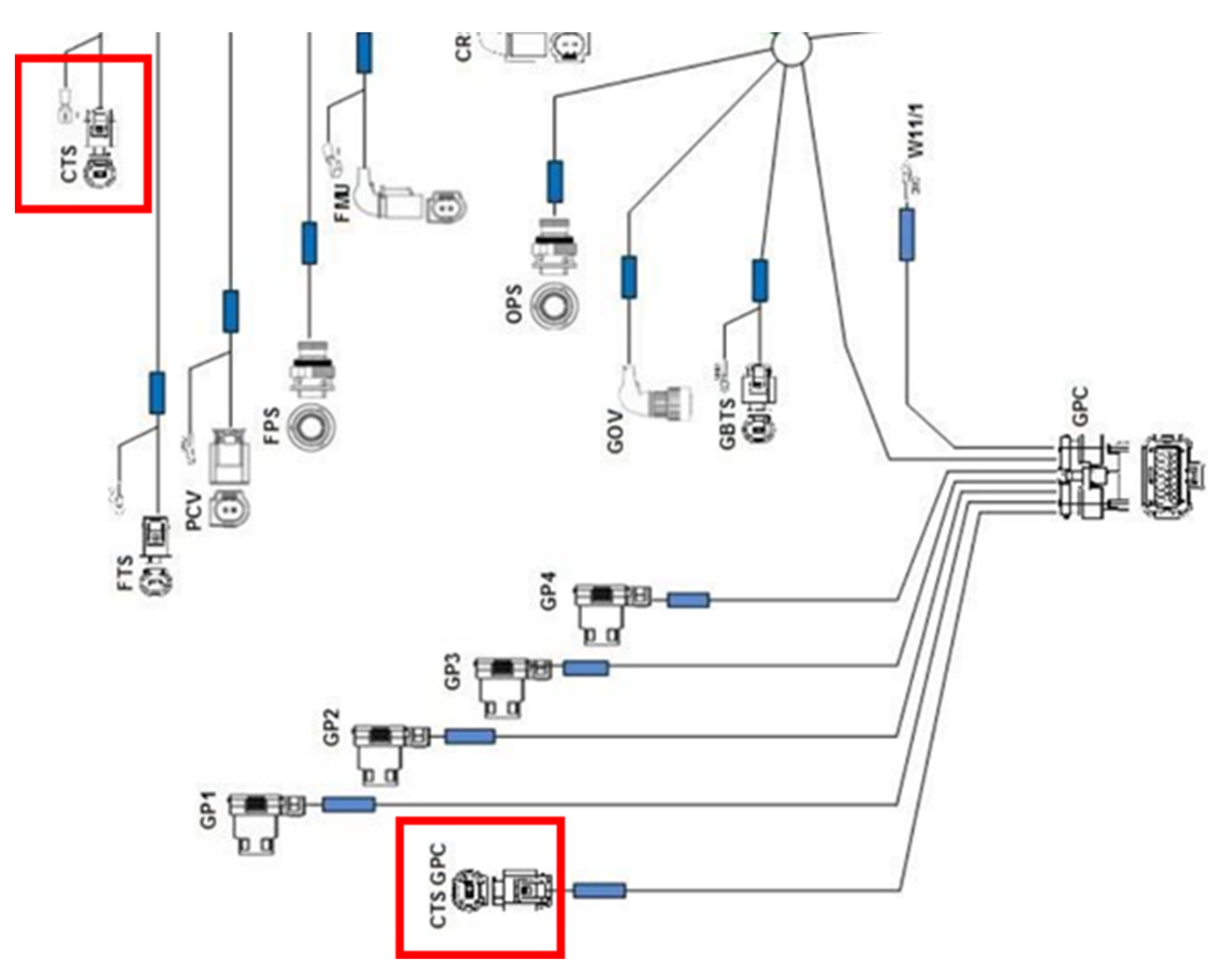An Analytical Study of the Elements of Airworthiness Certification Technology Based on the Development of the Conversion of Diesel Engines for Vehicles to Aviation
Abstract
:1. Introduction
2. Experimental Devices and Methods
2.1. Experimental Devices
2.1.1. Engine Selection
2.1.2. EASA Airworthiness Certification Data
2.2. Research Method
- Detaching the engines’ external parts: Accessories and components attached to the outsides of the engines were removed. This preparatory work was performed before gaining access to the engines’ bodies.
- Removing the engine block and head: The engine blocks and heads that protect the internal components were removed, allowing access to the insides of the engines.
- Disassembling the engines’ internal components: A wide range of components comprising the engines’ bodies were disassembled. In this stage, components such as the crankcase, cylinder head, piston, camshaft, and valve were disassembled, and their conditions and performance were examined.
- Cleaning: After disassembling the engines, each separate component was cleaned. This task entailed removing dust, oil, and contaminants and inspecting their condition.
2.2.1. Classification of the Engine Components Modified for Aircraft Use
2.2.2. Requirements for Material Selection and Anti-Loosening
2.2.3. Sensors Subject to Redundancy
3. Results
3.1. Classification of Components Modified for Aircraft Use
3.2. Requirements for Material Selection and Anti-Loosening
3.3. Sensors Subject to Redundancy
4. Conclusions
- The components of the alteration parts were analyzed from three different perspectives: performance, airworthiness, and layout. Based on this analysis, the automotive engine components modified for aircraft use were classified under classes A, B, and C depending on such perspectives.
- Based on the EASA airworthiness certification specifications, components under class A, which were subject to sensor redundancy, double locking, and heat or fire protection, were grouped according to the CS-E items. This grouping is expected to serve as a guideline for fabricating new components.
- To secure the required flame resistance and degradation protection, material reinforcements were made in the fuel lines, cooling lines, and harness components.
- Moreover, the anti-loosening ability was reinforced through safety wiring to prevent potential oil leakages from the oil-supplying devices.
- To secure single-fault tolerance, sensor redundancy was extensively explored, and detailed sensor-related criteria were presented, including the ones that distinguish sensors subject to redundancy from shared sensors.
Author Contributions
Funding
Institutional Review Board Statement
Informed Consent Statement
Data Availability Statement
Conflicts of Interest
Abbreviations
| UAM | Urban air mobility |
| EASA | European Union Aviation Safety Agency |
| CS-E | Certification Specifications and Acceptable Means of Compliance for Engines |
| FADEC | Full Authority Digital Engine Control |
| AD | Airworthiness Directive |
| SB | Service Bulletin |
| CRI | Common Rail Injector |
| EDC | Electronic Diesel Control |
| LOTC | Loss of Thrust Control |
| LOPC | Loss of Power Control |
| IPC | Illustrated Part Catalogue |
| CAS | Crank angle sensor |
| CPS | Cam position sensor |
| HPP | High-pressure pump |
| CTS | Coolant temperature sensor |
| IATS | Intake air temperature sensor |
| BPS | Boost pressure sensor |
| GPC | Glow plug control |
| EECU | Electrical Engine Control Unit |
| APS | Atmospheric pressure sensor |
| OLS | Oil level sensor |
| OTS | Oil temperature sensor |
| OPS | Oil pressure sensor |
| RPS | Rail pressure sensor |
| FPS | Fuel pressure sensor |
| FTS | Fuel temperature sensor |
| OTS_G | Gearbox oil temperature sensor |
References
- Hasan, S. Urban Air Mobility (UAM) Market Study; Crown Consulting, Inc.: Washington, DC, USA, 2019; No. HQ-E-DAA-TN70296. [Google Scholar]
- Straubinger, A.; Rothfeld, R.; Shamiyeh, M.; Büchter, K.-D.; Kaiser, J.; Plötner, K.O. An overview of current research and developments in urban air mobility–Setting the scene for UAM introduction. J. Air Transp. Manag. 2020, 87, 101852. [Google Scholar] [CrossRef]
- Rothfeld, R.; Straubinger, A.; Fu, M.; Al Haddad, C.; Antoniou, C. Chapter 13—Urban air mobility. Demand Emerg. Transp. Syst. 2020, 267–284. [Google Scholar] [CrossRef]
- Bulusu, V.; Onat, E.B.; Sengupta, R.; Yedavalli, P.; Macfarlane, J. A traffic demand analysis method for urban air mobility. IEEE Trans. Intell. Transp. Syst. 2021, 22, 6039–6047. [Google Scholar] [CrossRef]
- Fedorov, E.; Mingazov, A.; Ferenets, A. Features and limitations in the design of a light aircraft generation system. In Proceedings of the 2021 International Conference on Electrotechnical Complexes and Systems (ICOECS), Ufa, Russian Federation, 16–18 November 2021; IEEE: Piscataway, NJ, USA, 2021. [Google Scholar]
- Rendón, M.A.; Sánchez R., C.D.; Gallo, M.J.; Anzai, A.H. Aircraft hybrid-electric propulsion: Development trends, challenges and opportunities. J. Control. Autom. Electr. Syst. 2021, 32, 1244–1268. [Google Scholar] [CrossRef]
- Tiimus, K.; Murumäe, M.; Väljaots, E.; Tamre, M. High-Efficiency Internal Combustion Engine Used in the Unmanned Aircraft. Solid State Phenom. 2015, 220–221, 928–933. [Google Scholar] [CrossRef]
- Serbezov, V.S.; Nikolova, M.I. Comparative study of the energy efficiency of diesel and hybrid powered light aircraft. IOP Conf. Ser. Mater. Sci. Eng. 2020, 1002. [Google Scholar] [CrossRef]
- Xin, Q. Diesel Engine System Design; Elsevier: Amsterdam, The Netherlands, 2011. [Google Scholar]
- Heywood, J.B. Internal Combustion Engine Fundamentals; McGraw Hill: New York, NY, USA, 1988. [Google Scholar]
- Clothier, R.A.; Palmer, J.L.; Walker, R.A.; Fulton, N.L. Definition of an airworthiness certification framework for civil unmanned aircraft systems. Saf. Sci. 2011, 49, 871–885. [Google Scholar] [CrossRef]
- Kritzinger, D. Aircraft System Safety: Assessments for Initial Airworthiness Certification; Woodhead Publishing: Soston, UK, 2016. [Google Scholar]
- Haddon, D.R.; Whittaker, C.J. Aircraft airworthiness certification standards for civil UAVs. Aeronaut. J. 2003, 107, 79–86. [Google Scholar] [CrossRef]
- Batuwangala, E.; Silva, J.; Wild, G. The regulatory framework for safety management systems in airworthiness organisations. Aerospace 2018, 5, 117. [Google Scholar] [CrossRef]
- EASA. “Type Certificate Data Sheets” TCDS No.: E. 200, Issue: 12, 30 June 2020, Austro E4 Series Engines, Austro Engine GmbH, Rudolf-Diesel-Straße 11 A-2700 Wiener Neustadt, Austria, Initial Issue, 28 January 2009. Available online: https://www.easa.europa.eu/en/document-library/type-certificates?search=E.+200&year=&year_to= (accessed on 12 June 2023).
- EASA. “Airworthiness Directive” EASA AD No.: 2021-0203R1, TCDS Number(s): EASA.E.200, Effective Date (Original Issue): 14 September 2021, Austro Engine GmbH, Austria, Issued: 24 September 2021. Available online: https://www.easa.europa.eu/en/document-library/type-certificates?search=E.+200&year=&year_to= (accessed on 12 June 2023).
- Rudolf-Diesel-Straße 11 A-2700 Wiener Neustadt, “Mandatory Service Bulletin” No. MSB-E4-035/2, Supersedes MSB-E4-035/1; Austro Engine GmbH: Wiener Neustadt, Austria, 2021.
- Dattakumar, R.; Jagadeesh, R. A review of literature on benchmarking. Benchmarking Int. J. 2003, 10, 176–209. [Google Scholar] [CrossRef]
- Stapenhurst, T. The Benchmarking Book; Routledge: London, UK, 2009. [Google Scholar]
- Moriarty, J.P. A theory of benchmarking. Benchmarking 2011, 18, 588–611. [Google Scholar] [CrossRef]
- Yasin, M.M. The theory and practice of benchmarking: Then and now. Benchmarking 2002, 9, 217–243. [Google Scholar] [CrossRef]
- Anand, G.; Rambabu, K. Benchmarking the benchmarking models. Benchmarking 2008, 15, 257–291. [Google Scholar] [CrossRef]
- Dunz, R.; von Gregory, J.; Gulde, F.-P.; Herrmann, B.; Knauke, U.; Ruzicka, N.; Schommers, J. The new four-cylinder OM 640 diesel engine for the Mercedes-Benz A-class. MTZ Worldw. 2004, 65, 2–5. [Google Scholar] [CrossRef]
- Mohomad, S.S. Austro AE300 Engine as a platform for student research. In Proceedings of the ERAU(Embry-Riddle Aeronautical University), Discovery Day, Daytona Beach, FL, USA, 9 April 2014. [Google Scholar]
- Gęca, M.; Czyż, Z.; Sułek, M. Diesel engine for aircraft propulsion system. Combust. Engines 2017, 56, 7–13. [Google Scholar] [CrossRef]
- Saravanapprabhu, E.; Mahendran, M.; Periyasamy, S. An analysis of effect of variable compression ratio in CI engine using turbocharger. Int. Res. J. Eng. Technol. 2017, 4, 1129–1133. [Google Scholar]
- Heywood, J.B. Internal Combustion Engine Fundamentals, 2nd ed.; McGraw-Hill Education: New York, NY, USA, 2018. [Google Scholar]
- De Florio, F. Airworthiness: An Introduction to Aircraft Certification and Operations; Butterworth-Heinemann: Oxford, UK, 2016. [Google Scholar]
- Cuerno-Rejado, C.; Martínez-Val, R. Unmanned aircraft systems in the civil airworthiness regulatory system: A case study. J. Aircr. 2011, 48, 1351–1359. [Google Scholar] [CrossRef]
- Yang, K.; Liu, C. Comparison on the ways of airworthiness management of civil aircraft design organization. Procedia Eng. 2011, 17, 388–395. [Google Scholar]
- Özgen, S. Flight Safety, Airworthiness, Type Certificates, Design Requirements & Specifications. Middle East Technical University. Available online: http://144.122.72.2/~ae452sc2/lecture9_certification.pdf (accessed on 12 June 2023).
- CS-E. Certification Specifications and Acceptable Means of Compliance for Engines; EASA (European Union Aviation Safety Agency): Cologne, Germany, 2020. [Google Scholar]
- Westkämper, E.; Feldmann, K.; Reinhart, G.; Seliger, G. Integrated development of assembly and disassembly. CIRP Ann. 1999, 48, 557–565. [Google Scholar] [CrossRef]
- Go, T.F.; Wahab, D.A.; Rahman, M.N.A.; Ramli, R.; Hussain, A. Genetically optimised disassembly sequence for automotive component reuse. Expert Syst. Appl. 2012, 39, 5409–5417. [Google Scholar] [CrossRef]
- Hayhurst, K.J.; Maddalon, J.M.; Morris, A.T. A Review of Current and Prospective Factors for Classification of Civil Unmanned Aircraft Systems; NASA NTRS Technical Memorandum: Hanover, MD, USA, 2014. [Google Scholar]
- Mouritz, A.P. Introduction to Aerospace Materials; Elsevier: Amsterdam, The Netherlands, 2012. [Google Scholar]
- Williams, J.C.; Edgar, A.S., Jr. Progress in structural materials for aerospace systems. Acta Mater. 2003, 51, 5775–5799. [Google Scholar] [CrossRef]
- Halfpenny, A.; Walton, T.C. New techniques for vibration qualification of vibrating equipment on aircraft. Aircr. Airworth. Sustain. 2010, 2010, 19. [Google Scholar]
- Pérez-Grande, I.; Teresa, J.L. Optimization of a commercial aircraft environmental control system. Appl. Therm. Eng. 2002, 22, 1885–1904. [Google Scholar] [CrossRef]
- Jennions, I.; Ali, F.; Miguez, M.E.; Escobar, I.C. Simulation of an aircraft environmental control system. Appl. Therm. Eng. 2020, 172, 114925. [Google Scholar] [CrossRef]
- Gong, H.; Liu, J.; Feng, H. Review on anti-loosening methods for threaded fasteners. Chin. J. Aeronaut. 2022, 35, 47–61. [Google Scholar] [CrossRef]
- Saha, S.; Srimani, S.; Hajra, S.; Bhattacharya, A.; Das, S. On the anti-loosening property of different fasteners. In Proceedings of the 13th National Conference on Mechanisms and Machines (NaCoMM07), IISC, Bangalore, India, 12 December 2007; Volume 13. [Google Scholar]
- Aircraft Fasteners: A Description of Some of the Latest Aircraft Fasteners Which Are Being Produced by T. J. Brooks (Leicester) Ltd. Aircr. Eng. Aerosp. Technol. 1963, 35, 203–204. [CrossRef]
- Hess, D.P. Threaded fastener locking with safety wire and cotter pins. J. Fail. Anal. Prev. 2018, 18, 1216–1223. [Google Scholar] [CrossRef]
- Rudolf Diesel Straße 11 2700 Wiener Neustadt. “Maintenance Manual E4 Series” Doc. No.: E4.08.04, Revision:30; Austro Engine GmbH: Wiener Neustadt, Austria, 2021.
- Rudolf Diesel Straße 11 2700 Wiener Neustadt. “Operation Manual E4 Series” Doc. No.: E4.01.01, Revision:20; Austro Engine GmbH: Wiener Neustadt, Austria, 2016.
- Rudolf Diesel Straße 11 2700 Wiener Neustadt. “Installation Manual E4 Series” Doc. No.: E4.02.01, Revision:20; Austro Engine GmbH: Wiener Neustadt, Austria, 2015.
- He, T.; Zhang, L.; Kong, F.; Salekin, A. Exploring inherent sensor redundancy for automotive anomaly detection. In Proceedings of the 2020 57th ACM/IEEE Design Automation Conference (DAC), San Francisco, CA, USA, 20–24 July 2020; IEEE: Piscataway, NJ, USA, 2020. [Google Scholar]
- Amato, F.; Cosentino, C.; Mattei, M.; Paviglianiti, G. A direct/functional redundancy scheme for fault detection and isolation on an aircraft. Aerosp. Sci. Technol. 2006, 10, 338–345. [Google Scholar] [CrossRef]
- Berdjag, D.; Zolghadri, A.; Cieslak, J.; Goupil, P. Fault detection and isolation for redundant aircraft sensors. In Proceedings of the 2010 Conference on Control and Fault-Tolerant Systems (SysTol), Nice, France, 6–8 October 2010; IEEE: Piscataway, NJ, USA, 2010. [Google Scholar]
- Mehranbod, N.; Soroush, M.; Panjapornpon, C. A method of sensor fault detection and identification. J. Process Control. 2005, 15, 321–339. [Google Scholar] [CrossRef]
- Hu, J. The aircraft airworthiness and safety standards analysis. Appl. Mech. Mater. 2014, 533, 371–374. [Google Scholar] [CrossRef]
- Nelson; Rino, N.; Prasad, N.S.; Sekhar, A.S. Structural integrity and sealing behaviour of bolted flange joint: A state of art review. Int. J. Press. Vessel. Pip. 2023, 204, 104975. [Google Scholar] [CrossRef]
- Lošák, P.; Létal, T.; Naď, M.; Pernica, M. Tightness of flange joints: A case study. IOP Conf. Ser. Mater. Sci. Eng. 2020, 776, 012037. [Google Scholar] [CrossRef]
- Abonyi, S.E.; Okafor, A.A.; Princewill, O.C. Performance Evaluation Engine of Sensors in Automobile System. Int. J. Trend Sci. Res. Dev. 2022, 6, 2119–2128. [Google Scholar]






| Model | OM640 | AE300 |
|---|---|---|
| Pictures |  |  |
| Form | Inline-4 | Inline-4 |
| Displacement (cc) | 1991 | 1991 |
| Compression ratio | 18.0 | 17.5 |
| Power (PS) | 140 | 168 |
| * Weight (kg@Dry) | 168 | 163 |
| Power-to-weight ratio | 0.83 PS/kg | 1.03 PS/kg |
| Block material | Cast iron | Cast iron |
| FIE (Fuel Injection Equipment) | 1600 bar CRI2-16/EDC16 | 1600 bar CRI2-16/EDC16 |
| Turbocharger | Waste gate | Waste gate |
| Max. boost (bar) | 1.4 | 1.75 |
| Oil volume (L) | 5.8 | 7.5 |
| CS-E Number | CS-E Content |
|---|---|
| CS-E 50 (c)-(2) | In the full-up configuration, the system is essentially single-fault tolerant for electrical and electronic failures with respect to LOTC/LOPC (Loss of Thrust Control/Loss of Power Control) events. |
| CS-E 80 (a)-(2)-(i) | Mountings and drives for equipment must be designed and located so as to minimize the possibility of defective equipment necessitating engine shut-down as a result of contamination or major loss of the engine oil supply. |
| CS-E 90 (a) | Each engine component and each item of equipment must be protected from corrosion and deterioration in an approved manner. |
| CS-E 130 (b) | Each external line, fitting, and other components that contain or convey flammable fluid during normal engine operation must be at least fire resistant. Components must be shielded or located to safeguard against the ignition of leaking flammable fluid. |
| CS-E 130 (g)-(2)-(ii) | Those features of the engine that form part of the mounting structure or engine attachment points should be at least fire resistant. |
| CS-E 250 (d) | It should not be possible for fuel to drain into the engine when it is not running in such quantities as to introduce a risk of “hydraulicing” or in any way adversely affect the mechanical reliability of the engine. |
| Class | Design-Related Priority for the Alteration Parts |
|---|---|
| A | Subject to airworthiness certification requirements |
| B | Subject to layout requirements |
| C | Subject to target performance |
| Design Modification | Purpose of Design Modification | ||
|---|---|---|---|
| Class A (Airworthiness) | Class B (Layout) | Class C (Performance) | |
| CAS (crank angle sensor) | ● | ||
| Cylinder head cover | ● | ||
| CPS (cam position sensor) | ● | ||
| Camshaft | ● | ||
| Vacuum pump (sensor housing) | ● | ||
| HPP (high-pressure pump) | ● | ||
| Common-rail return line | ● | ||
| Intake manifold | ● | ||
| CTS (coolant temperature sensor) | ● | ||
| IATS (intake air temperature sensor) | ● | ||
| BPS (boost pressure sensor) | ● | ||
| Water outlet | ● | ||
| Water inlet pipe | ● | ||
| Turbocharger | ● | ||
| Exhaust manifold | ● | ||
| Oil pump | ● | ||
| Oil pan | ● | ||
| Oil filter housing assembly | ● | ||
| Oil separator | ● | ||
| Reed injector cover | ● | ||
| Belt take up | ● | ||
| Generator | ● | ||
| Starter | ● | ||
| GPC (glow plug control) harness | ● | ||
| Component | [Class A] OM640 ⟶ AE300 Analysis Results of Engine Conversion |
|---|---|
| CAS (crank angle sensor) | Sensor redundancy |
| CPS (cam position sensor) | Sensor redundancy |
| HPP (high-pressure pump) | Newly installed relief valves for aircraft safety |
| Common rail return line | Material change and reinforcement |
| CTS (coolant temperature sensor) | Shared sensor; no redundancy due to different roles of CTS#1 and CTS#2 |
| IATS (intake air temperature sensor) | Sensor redundancy |
| BPS (boost pressure sensor) | Sensor redundancy |
| Water outlet | Double clamp, shape, and material change |
| Water inlet pipe | Material change and new fabrication |
| Reed injector cover | Newly installed for backfire inspection |
| GPC (glow plug control) harness | Material change and reinforcement |
| Component | Analysis Results of Engine Conversion | Applied CS-E |
|---|---|---|
| Common-rail return line | Material change and reinforcement | CS-E 90 (a), CS-E 130 (b), CS-E 130 (g)-(2)-(ii) |
| Water outlet | Double clamp, shape, and material change | |
| Water inlet pipe | Material change and new fabrication | |
| GPC (glow plug control) harness | Material change and reinforcement |
| Affected Areas | Bolt Specifications | Torque Tightening (Nm) | Applied CS-E |
|---|---|---|---|
| Turbocharger oil feeding and bleeding line banjo bolt | Banjo | 25 | CS-E 80(a)-(2)-(i), CS-E 250 (d) |
| Banjo bolt of HPP fuel return line | Banjo | 25 | |
| Banjo bolt of oil filter drain line | Banjo | 30 | |
| Banjo bolt of HPP fuel return line | Banjo | 15 | |
| Turbocharger oil feeding line banjo bolt | Banjo | 35 | |
| Turbocharger oil bleeding banjo bolt | Banjo | 50 | |
| Drain plug of engine oil pan | Hexagon | 30 | |
| Maintenance lid screw on injector cover | Hexagon | 3 | |
| Filler plug on gearbox | Hexagon | 12 | |
| Screw of the spring band clamp | Hexagon | 5 | |
| Filler plug on gearbox | Hexagon | 12 | |
| Gearbox oil filter | Hexagon | 25 |
| Division | Sensor | Mounting Position | Applied CS-E |
|---|---|---|---|
| Engine | CAS (crank angle sensor) | Gearbox | CS-E 50 (c)-(2) |
| CPS (cam position sensor) | Cylinder head cover | ||
| BPS (boost pressure sensor) | Intake manifold | ||
| IATS (intake air temperature sensor) | Intake manifold Intercooler pipe |
| Division | Sensor | Mounting Position |
|---|---|---|
| Engine | CTS (coolant temperature sensor) | Intake manifold |
| CTS_GPC (coolant temperature sensor) | Intake manifold | |
| APS (atmospheric pressure sensor) | Built-in EECU | |
| OLS (oil level sensor) | Oil pan | |
| OTS (oil temperature sensor) | Oil pan | |
| OPS (oil pressure sensor) | Oil filter | |
| RPS (rail pressure sensor) | Common rail | |
| FPS (fuel pressure sensor) | High-pressure pump inlet | |
| FTS (fuel temperature sensor) | High-pressure pump inlet | |
| Gearbox | OTS_G (gearbox oil temperature sensor) | Gearbox |
| Sensor FADEC A | CAS | → FADEC A → | Relay Matrix → | Actuators |
| CPS | ||||
| BPS | Injectors (4) | |||
| IATS | ||||
| Shared Sensors | CTS | ↑ Shared Sensor Signal Conditioning ↓ | ||
| CTS_GPC | Boost Pressure Actuator | |||
| APS | ||||
| OLS | ||||
| OTS | Rail Pressure Control Valve | |||
| OPS | ||||
| RPS | ||||
| FPS | ||||
| FTS | Governor Actuator | |||
| OTS_G | ||||
| Sensor FADEC B | CAS | → FADEC B → | ||
| CPS | Fuel Metering Unit | |||
| BPS | ||||
| IATS |
Disclaimer/Publisher’s Note: The statements, opinions and data contained in all publications are solely those of the individual author(s) and contributor(s) and not of MDPI and/or the editor(s). MDPI and/or the editor(s) disclaim responsibility for any injury to people or property resulting from any ideas, methods, instructions or products referred to in the content. |
© 2023 by the authors. Licensee MDPI, Basel, Switzerland. This article is an open access article distributed under the terms and conditions of the Creative Commons Attribution (CC BY) license (https://creativecommons.org/licenses/by/4.0/).
Share and Cite
Lim, J.; Lee, S.; Chung, J.; Kim, Y.; Park, G. An Analytical Study of the Elements of Airworthiness Certification Technology Based on the Development of the Conversion of Diesel Engines for Vehicles to Aviation. Aerospace 2023, 10, 738. https://doi.org/10.3390/aerospace10090738
Lim J, Lee S, Chung J, Kim Y, Park G. An Analytical Study of the Elements of Airworthiness Certification Technology Based on the Development of the Conversion of Diesel Engines for Vehicles to Aviation. Aerospace. 2023; 10(9):738. https://doi.org/10.3390/aerospace10090738
Chicago/Turabian StyleLim, Junwoo, Seangwock Lee, Jaeyeop Chung, Youngwan Kim, and Giyoung Park. 2023. "An Analytical Study of the Elements of Airworthiness Certification Technology Based on the Development of the Conversion of Diesel Engines for Vehicles to Aviation" Aerospace 10, no. 9: 738. https://doi.org/10.3390/aerospace10090738
APA StyleLim, J., Lee, S., Chung, J., Kim, Y., & Park, G. (2023). An Analytical Study of the Elements of Airworthiness Certification Technology Based on the Development of the Conversion of Diesel Engines for Vehicles to Aviation. Aerospace, 10(9), 738. https://doi.org/10.3390/aerospace10090738






